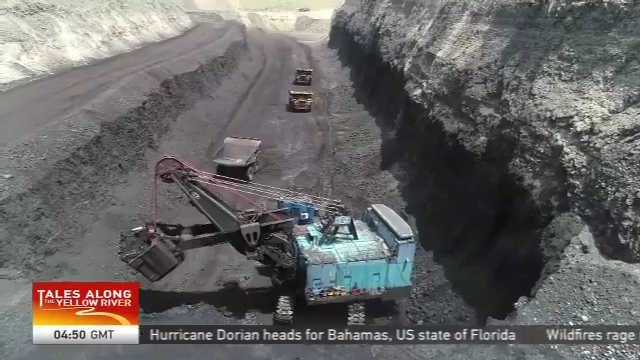
14:17, 30-Aug-2019
Tales Along the Yellow River: Inner Mongolia switches to greener, more effective coal production
Updated
14:41, 30-Aug-2019

We continue with our special series, Tales Along the Yellow River. As the river flows north from Ningxia Hui Autonomous Region, it begins a great bend known as the "Ordos Loop", following which the Yellow River runs through another autonomous region - Inner Mongolia before turning south again. The Ordos basin, with its abundant reserves of coal, oil, and natural gas, is dubbed China's "energy bank for the 21st century" and Inner Mongolia, in particular, has been the nation's top coal producer for a decade. However, with so much of China's smog and over-capacity problems stemming from the coal industry, Inner Mongolia is now taking the lead in building a greener and more modernized coal economy. CGTN's Xu Mengqi reports from the city of Ordos.
An oath taken in the name of family happiness. A daily reminder for coal miners that safety can never be taken lightly.
Dai Zhigang understands the potential risks of his job. In underground mining, floods, poisonous gases, roof collapse and explosions are common causes of fatal accidents.
And yet as an engineering major, and a mining technician for 9 years, Dai says the increasingly mechanized mining operations in his company provide him with a strong sense of security.
DAI ZHIGANG, MINING TECHNICIAN INNER MONGOLIA YITAI COAL CO.,LTD "When I first came along we hadn't yet adopted the electronic hydraulic support system, and we had to manually control each of the jacks through a handle. It was much more labor intensive."
Dai's experience tells the story of a changing coal industry in China.
With simpler geographical conditions than traditional mining areas in the east, Ordos, and western China in general, are becoming the nations new coal supply centers, where more advanced equipment and techniques are helping to churn out the fossil fuel more effectively and substantially lower mining fatality rates.
And yet China has long faced a coal conundrum. As the world's biggest producer and consumer of the fossil fuel, the nation has now pledged to slash coal consumption in a bid to reduce pollution and carbon emissions.
HUO LIPING, DEPUTY DIRECTOR ORDOS ENERGY BUREAU "Ordos has cut 130 million tons of capacity and is in line with the national policy. We are guiding small mines with an annual capacity below 600,000 tons or those with outdated equipment to gradually exit the market."
The capacity quota of small coal mines will be given to bigger, and more modernized ones. But even authorized miners face stricter industry regulations.
XU MENGQI ORDOS, INNER MONGOLIA "Any mining activities, whether it's underground mining or opencast mining, means a certain amount of land will be destroyed. But these days, with environmental protection high on the government's agenda, local mining companies say they will not be allowed to continue production unless they recover the destroyed land."
PANG JUNLIN, CHIEF ENGINEER INNER MONGOLIA YITAI COAL CO.,LTD "In shaft mining, the ground subsides and cracks, so you need to restore the ecological system. And in strip mining, there is environmental damage too. Now there are some relatively mature technologies that allow us to restore the original topography, vegetation and to enrich the soil."
So as it turns out, Ordo's coal mining industry is much more modernized than many think. And there is no doubt that during this industrial upgrade towards greener and more efficient mining technologies, more and more smaller coal companies will be phased out. Another cost, of sorts, to development. XMQ, CGTN, Ordos, Inner Mongolia.
SITEMAP
Copyright © 2018 CGTN. Beijing ICP prepared NO.16065310-3
Copyright © 2018 CGTN. Beijing ICP prepared NO.16065310-3